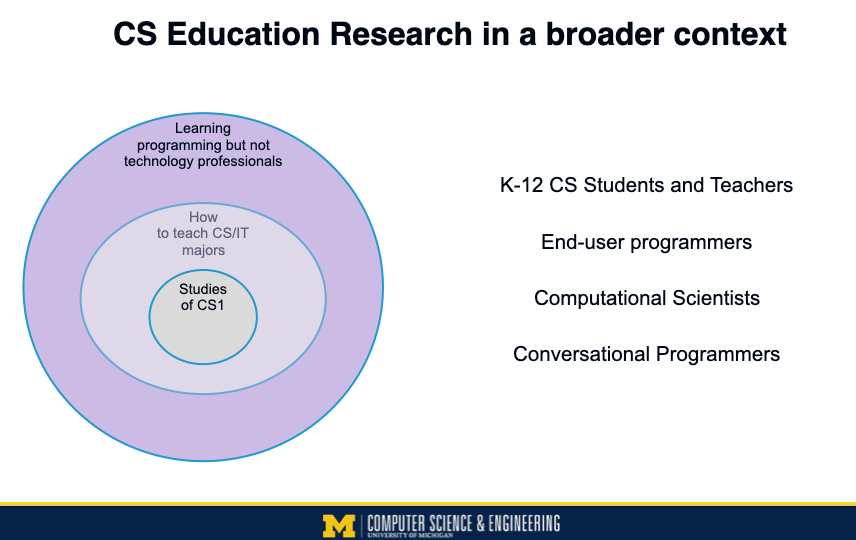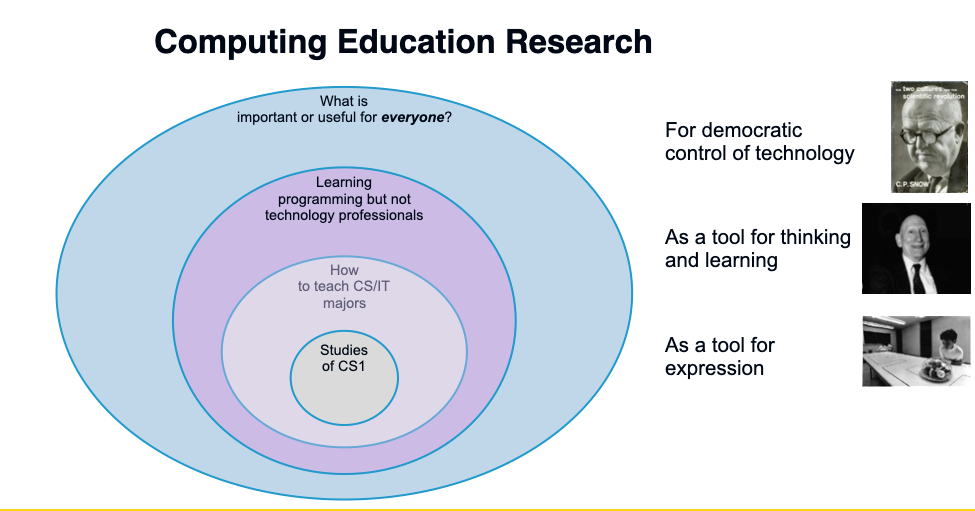Three types of computing education research: for CS, for CS but not professionally, and for everyone
May 25, 2022 at 7:00 am 2 comments
In February, I was invited to give a lecture at the University of Washington’s Allen School. I had a great day visiting there, even though it was all on Zoom. My talk is available on YouTube:
I got a chance to talk to Jeff Heer and Amy Ko before my visit. The U-W CSE department had been thinking about making a push into computing education research. They suggested that I describe the lay of the land — and particularly, to identify where I fit in that space. What I do these days (e.g. Teaspoon languages for history and mathematics classes) isn’t in the mainstream of computing education research, and it was important to tell people unfamiliar with the field, “There’s a lot more out there, and most of it doesn’t look like this.”
CS Education research dates back to the late 1960’s (see the history chapter that Ben du Boulay and I wrote). ACM SIGCSE started in 1968 with a particular focus on how to teach Computer Science and Information Technology majors. Much of what SIGCSE has published is focused even more specifically on the first course, which we now call CS1. This is a big and important space. These majors will be significant drivers of the world’s infrastructure.

There is a growing trend in computing education research to look at people who are learning programming (like in the first circles), but not for the purpose of becoming technology professionals. This includes K-12 CS teachers, end-user programmers, and conversational programmers. This kind of research sometimes appears in venues like CHI, CSCW, and VL/HCC, and occasionally in venues like SIGCSE, RESPECT, and ITiCSE. These circles aren’t scaled correctly by size of potential student population. By most measures, the outer circle (of people learning programming but who aren’t going to become technology professionals) is at least ten times the size of the student population inside the first circles.

My research is one level further out. I’m interested in studying what should we be teaching to everyone, whether or not they’re going to program like professionals, and how do we facilitate that learning. These students might not use the same tools or languages, and certainly have different goals for studying computing. I offer three reasons for the broader “everyone” to learn computing (drawn from the work of C.P. Snow, Alan Perlis, Peter Naur, and Seymour Papert — see this earlier blog post):
- To make sure that technology is controlled by a democracy.
- To support new ways of thinking and learning.
- To be part of a new computational literacy, a new tool for human expression.
This outer circle is far bigger in terms of number of students potentially impacted than any of the inner circles. But it’s also where we know the least in terms of research results.

Take a look at the talk for more on this way of thinking about the field, and how I connect that to existing research. I’d be interested in your perspective on this framing.
Entry filed under: Uncategorized. Tags: computing education research.
2 Comments Add your own
Leave a comment
Trackback this post | Subscribe to the comments via RSS Feed
1. mlmiller (@mlmiller) | May 26, 2022 at 1:41 pm
mlmiller (@mlmiller) | May 26, 2022 at 1:41 pm
Nice post. Brings some clarity, at least in theory. I wonder if more accessible tools/languages could help blur the distinctions between the outer two circles, perhaps enlarging the inner of the two?
2. Mark Guzdial | May 26, 2022 at 2:06 pm
Mark Guzdial | May 26, 2022 at 2:06 pm
I think the differences are more about context. The outer circle doesn’t necessarily care about learning CS. They want programming in the terms they do care about. Is that accessibility?